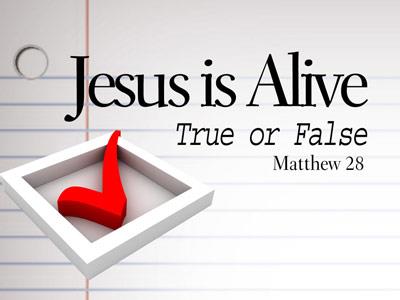-
Jesus Is . . . The Risen Savior Series
Contributed by Joe La Rue on Nov 28, 2017 (message contributor)
Summary: An examination of the evidence for the resurrection of Jesus.
Title: Jesus Is . . .The Risen Christ
Series: Who Is Jesus? (Sermon # 4)
Text: 1 Cor 15:3-8
March 23, 2008 (Easter Sunday)
COPYRIGHT © Joe La Rue, 2008
INTRODUCTION
A. Perhaps the most famous missing man in American history is Judge Joe Crater, who was an associate justice of the New York Supreme Court when he vanished without a trace in August, 1930. One of the most recognizable people in New York City, he was vacationing with his wife in Maine when he received a phone call and told her only that he had to return to the city to straighten some things out. Before leaving, he promised to return in time for her birthday in just a few days. His wife later reported that when he left, he was behaving normally and seemed to be in good spirits.
It is known that he went back to the city and spent two hours looking through his files in his courthouse chambers. He then had his assistant, Joseph Mara, cash two checks for him that totaled $5,150—equal to roughly $60,000 today. Around lunchtime, the assistant helped him carry two locked briefcases to his apartment, where Judge Crater dismissed him for the day.
Later that evening, Judge Crater bought a ticket for the Broadway comedy Dancing Partner that was playing later that night. He then went to dinner at Billy Haas’s Chophouse on West 45th Street, where he ate with an attorney friend of his. The lawyer would later tell police that Judge Crater was in a good mood during dinner and gave no indication that anything was amiss.
Around 9 p.m., shortly after the opening time for Dancing Partner, Judge Crater and the lawyer left the restaurant. Judge Crater hailed a cab, and before stepping in waved back to his friend. That was the last anyone ever saw him.
What happened to Joe Crater remains a mystery. The nation became engrossed with the massive investigation for the missing judge. It was discovered that the judge’s safe deposit box had been cleaned out, and the two briefcases that Joseph Mara helped him carry to his apartment were missing. How can such a prominent person simply vanish without a trace? Had he been murdered because he was about to expose corruption in Tammany Hall? Or, was he himself involved in corruption, and he ran away? Could it be that he intended to use the cash to pay off someone, and the deal went bad? It is known that he was having an affair with a 22 year old dancer: some have speculated that she was also seeing a mobster. Could the mobster boyfriend have had the judge killed? Or, could he have run off with another woman? Or, maybe with the dancer? She herself disappeared two months later and was never seen again. Or, perhaps he had been killed by a mob boss as a political favor to politicians who were protecting the mob. No one could say. It was as if he had vanished into thin air.
In October a grand jury was convened, which expressed the opinion that, “The evidence is insufficient to warrant any expression of opinion as to whether Crater is alive or dead, or as to whether he has absented himself voluntarily, or is the sufferer from disease in the nature of amnesia, or is the victim of crime.”
Joe Crater had simply disappeared, never to be seen again.
(Joseph Force Crater, Wikipedia, http://en.wikipedia.org/wiki/Joseph_F._Crater (last visited Mar 18, 2008)).
B. Occasionally people go missing, with no way to tell whether they are dead or alive. But seldom do you encounter someone who claims to have come back from the dead. Unlike the case of Judge Crater, the issue with Jesus isn’t that He was nowhere to be seen. Rather, it’s that He was seen: He was seen dead, He was seen locked in a tomb, and then He was seen alive again. The story of Easter is not the story of a missing person. Rather, it’s the story of Jesus being raised from the dead, and remaining alive down to the present time. The Apostle Paul wrote in the Bible,
“For what I received I passed on to you as of first importance: that Christ died for our sins according to the Scriptures, that he was buried, that he was raised on the third day according to the Scriptures, and that he appeared to Peter, and then to the Twelve. After that, he appeared to more than five hundred of the brothers at the same time, most of whom are still living, though some have fallen asleep. Then he appeared to James, then to all the apostles, and last of all he appeared to me also, as to one abnormally—[or, untimely]—born.” (1 Cor 15:3-8, NIV).
C. Sceptics, though, say that the evidence for the resurrection is as inconclusive as the evidence for the fate of Judge Crater: there is simply not enough proof to reach a firm conclusion. Some go even farther and assert that there is no evidence that Jesus was raised from the dead, and the whole thing is nothing but a fairy tale. So, who’s right? Is there evidence that Jesus rose from the dead? Actually, there is. In fact, I maintain that an honest consideration of the evidence will lead to the conclusion that Jesus really did rise from the dead on Easter Sunday morning.

 Sermon Central
Sermon Central



